
Export Files
The Export functionality is used to collect information from different views/tables and export the data to an ASCII text and XML file. Select Miscellaneous>File Export or Configuration>External> File Exports>Export Files to access the file export functionality. In OCMM, select Miscellaneous>Exports to access this tool.
Note: PMS add-on license OPP_EXP Export Files controls availability of this feature.
Note: Should a property have the OPP_PMS license active, OPP_S&C license active, OPP_BO add-on license inactive, OPP_EXP add-on license inactive, OPP_ESM add-on license inactive, OPP_COM add-on license active, Commission>Positive Pay Check Export application parameter is inactive, and Exports>Country Export application function is inactive, the Configuration>External menu option will no longer display without any menu options.
To select a new export from the generic templates, select the New button. You are prompted to select from the existing templates that are available or make a customized new export.
The export file operation typically consists of the following steps:
Select the menu option Configuration>External>Export Files. All generic exports provided by OPERA SID data are available here. The Export File List screen shows the File Type (the export file name) and Description (description of the export).
Automatic Generation of Export Files. A procedure for creating export files (GENERATE EXPORT NA DATA) in End of Day (Night Audit) processing. Only files selected for Night Audit processing in the export setup are run automatically.
Manual Generation of Exports Files. You can manually create export files as needed or in case the End of Day routine procedure did not produce the desired export. To do so, select Miscellaneous>File Export>General (Sales and Catering exports, Country exports, Memberships exports, Commission exports and other types of exports are available based on parameter settings or licenses).
Creation of New Exports. In addition to the standard exports provided as OPERA SID data, you can create additional new exports from scratch or by using the existing standard exports as templates and making modifications. This can be done by selecting Configuration>External>Export Files.
Note: Creating new exports requires a basic knowledge of SQL and OPERA views and tables.
The location of the directory where OPERA export files are stored is defined in the default_<schema>.env file environment variable (default_brisbane.env), FORMS90_output. At installation, this variable is set to D:\micros\opera\export. Use oappcfged.exe to make configuration changes.
As an alternative to mapped drives, UNC (Universal Naming Convention) network share paths (e.g., \\app_server1\micros\opera\export) are also supported. This is also applicable for the zipping of the export files if the zip file name is defined in the export file details.
The following information is provided to assist in configuring OPERA systems which exchange (export) information to and from third-party systems. You will need to create (or ensure that there are) the local directory (folder) on the application web server as explained in the following section.
With this module, information/data is written into the designated folder where it will be picked up by the third-party system. This directory is the same path as used by all export routines that are transmitted from OPERA. For example:
D:\micros\opera\export
Note that unlike the import directory you need not specify the schema name and property IDs as these will be defined automatically when the exports are created.
Once the directories have been created, verify that the FORMS90_output environment variables on the application server point to the export base of the directories defined in the previous step (subtract property ID and schema name to obtain export base). These should already match and no changes should be required. For example, the standard and recommended default settings are:
FORMS90_OUTPUT = D:\micros\opera\export
The Export File List screen is used to collect information from different views/tables and export the data to an ASCII text file. The screen displays all generic exports provided by OPERA SID data. From this screen, users are able to Generate and view export data files, and also alter export file configurations. To access the Export File List screen, select Miscellaneous>File Export or Configuration>External> Export Files.
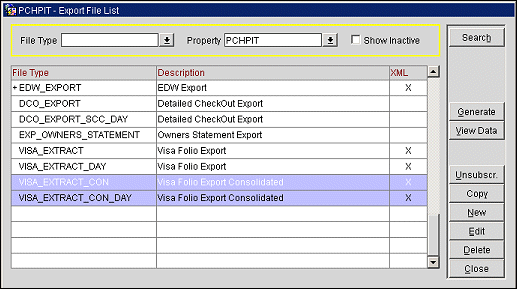
Complete one or more of the following search criteria and select the Search button.
File Type. Select from the lists of values the file type to be exported explained in the Grid below
Property. If the OPP_MHOT Multi Property PMS add-on license is active, select the property you want to export file type information from.
Show Inactive. Display all inactive file types.
For a complete list of the File Exports, see the Available Export Data Definition help topic.
Note: When the Exports>Multi Property Export VISA application parameter is set to Y, any exports that are setup to run for multiple properties will have a light blue background as seen in the following image for the VISA_EXTRACT_CON and VISA_EXTRACT_CON_DAY.
The results displayed in the grid depend on the search criteria entered by the user.
File Type. Name of the export file.
Description. Description of the export.
XML. X in this column indicates that the export uses an XML format. (See Export File Details - Creating and Editing Export Files, below.)
Generate. Start the export data generation. When generation is complete, you are asked whether you wish to view the generated data. If you select Yes, the Export Data List screen appears. This screen lists export files by date generated. The most recently generated export file is at the top of the list (See View Export Data for details).
(See Generate Export Data for details).
View Data. View the export data which has already been created. (See View Export Data for details).
Unsubscr. Available when a multi-property Export is highlighted, select to un-subscribe one or more properties from the export.
Copy. Copy one setup to another.
New. Create a new export setup. You are prompted to select from the existing templates that are available or make a customized new export.
Note: By default, only generic export templates are displayed in the Export File List. Other export templates may be available to you depending on the Config. Mode and Country Mode set on the Property Configuration screen.
Note: Exporting membership statements is a common, customized export function within ORS/OCIS (when the OPR <version number> ORS and OCIS license code is active). See Membership Statements - Export for more information.
Note: For information about the handling of credit card information in export files, see Credit Card Information Handling, below.
Refer to Export File Details - Creating and Editing Export Files, below.
Edit. Edit an export setup. Refer to Creating and Editing Export Files, below.
Delete. Delete an export setup only if an export file has not been generated for this export.
Note: In case of VISA_EXTRACT_CON export, deleting the export from one property will delete it from all the subscribed properties, irrespective of the user access /permissions to these properties.
Note: When no exports are displayed in the grid, the Generate, View Data, Edit, Copy, and Delete buttons are not available. These buttons are available only when at least one export that has been configured for the property is listed in the grid. The export may be active or inactive.
The Delivery Method Maintenance screen is used to set up the export file delivery configuration option and associate it with an export file. This separates the export file and delivery method configuration so that it is not necessary to configure the same delivery method for several exports, therefore avoiding duplicate configurations and preventing overwriting when changes via the export file template are applied. To access the Delivery Method Maintenance screen, select Configuration>Property>Delivery Method:
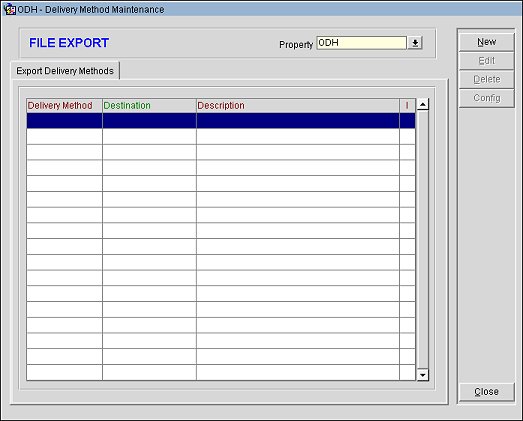
Note: If any destination code is attached to an active export, it cannot be deleted.
Select the New button to select the delivery method from the Export Delivery Methods screen.
This set up is independent of any specific export file and is maintained at a single location. This allows the association of an export delivery destination with an export file in the event that it is overwritten with a template. You can simply reattach the previous destination code on the updated Export File Details screen, and all the delivery configuration details with that code will remain unchanged. You can configure all delivery methods at one place and simply attach the desired code to any specific export.
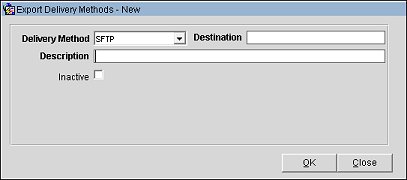
Delivery Method. Select the delivery method: OXI, HTTP, or SFTP. This delivery method will be added to the File Export screen above.
Destination. Enter the export delivery method destination. Only one export delivery destination can be selected per export. This destination will be added to the File Export screen above.
Description. Enter the export delivery method description. This description will be added to the File Export screen above.
Inactive. Select this check box to make a file type inactive.
Type. Only available when the OXI delivery method is selected. Enter up to 20 characters that will be used to uniquely identify the OXI action type.
Interface. Only available when the OXI delivery method is selected. Select the down arrow to choose the third-party system to which OPERA connects through OXI.
HTTP Address. Only available when the HTTP delivery method is selected. Enter the database HTTP address where the export file will be uploaded to.
Protocol. Only available when the HTTP delivery method is selected. If you are communicating with a Web Service, select the protocol used for extracting XML (e.g., SOAP) from the uploaded file.
SOAP Action. Available when SOAP is selected in the Protocol field. Enter the SOAP action, if any, to be applied by the Web Service.
See OXI - Export File Delivery Configuration Screen, SFTP Export File Delivery Configuration Screen, and HTTP/HTTPS Export File Delivery Configuration Screen below for additional information.
To create a new export, from the Export File List screen, select New. You may create the export file by copying an existing export file as a template, and editing it, if necessary, or by "starting from scratch" with a blank Export File Details screen. If you select the template option, you are prompted to select the export file type(s) to be copied as templates. If the OPP_MHOT Multi-property license code is active, you are prompted to select the property or properties to which you want to copy them (the current property is selected by default).
The Export File Details screen allows you to specify the particular features of the export file.

Note: To copy an existing export file delivery configuration to the Delivery Method Maintenance screen, right-click anywhere on the Export File Details screen and then click 'Copy to Export Delivery Methods'. The Export Delivery Methods screen displays.
Provide the following information and select the OK button.
File Type. Name of the export. To create a new file type, select New from the Export File List and enter a new file type name for the export.
XML. When selected, the export will generate via XML messaging. By default, this check box will be selected and unavailable if the export has been created as an XML export. It is available to be selected when the export is configured manually (rather than being created from a pre configured template) as an XML export. See XML Export Configuration for details.
Note: By default, the File Extension Formula field populates with 'XML' when this check box is selected. File Extension Formula can, however, be edited if you wish to change the filename extension.
XML Doc. Available when the XML check box is selected. In this field specify the name of a wrapper tag for the export. For example, if you wanted the XML export to begin with a tag <umf> and end with a tag </umf>, you would specify umf in this field. Additionally, select the ellipsis button to further configure the XML.
File Description. Long description of the export file type.
Export Source. Select the down arrow to choose from a list of available views for the export procedure.
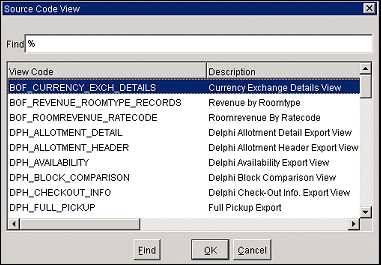
Source Description. The description will be automatically populated when the Export Source view is selected.
Note: When the EXP_SCACTIVITY_VIEW data source is used, and the Activity>Use Time Zones for Activities application parameter is set to Y, date and time information related to activities is converted to the logged-in user's time zone; if no time zone is specified for the logged-in user, the logged-in property time zone is assumed; if the logged-in property does not have a time zone assigned, the database time zone is assumed. See Activity Time Zones for details.
Pre Export Procedure. Internal setup procedure which will be executed before the data export is done. The pre-export procedure is a pre-processor that populates and filters views and sets variables.
Post Export Procedure. Internal setup procedure which will be executed after the data export is done. The post-export procedure is a post-processor that truncates temp tables following export generation and may also reset parameters that were set for the export.
Parameter Form. Used for exports that can be manually generated. This field contains the name of the parameter form which is used to generate a manual export. The parameter form prompts for the required input from the user in order to generate a manual export. An example of the required parameters is the date range for which the export needs to be run. Each pre-export procedure has a unique parameter form, as the procedure is hard-coded within the form. Normally, if the parameter form is used, the pre- export procedure need not be used, but this can vary depending on the definition of the export.
Note: When automatically generating exports via End of Day processing, a parameter form should not be used because the export is generated automatically and there is no opportunity for manual input.
Night Audit Export. Check this box if the export is to be run during the End of Day procedures.
Note: When an export is set up to run during the End of Day (Night Audit) procedures, a frequency can be selected to generate this particular export file during the End of Day process. In the event user selects such an export and manually generates the export file, the setting in the Frequency field is ignored and the export will be generated irrespective of the frequency setting. In addition, the export will still automatically generate an export file based on the Frequency during the End of Day process.
Frequency. When the Night Audit Export check box is selected, select the down arrow to select the frequency of how often the export is to be run during the night audit process. Will it be run Daily, End of month, End of Year, or Weekly.
Other export disposition options are listed below Night Audit Export. No more than one of these options may be selected.
Delivered Via. Select the down arrow to select the delivery method: OXI, SFTP, HTTP, or PREDEFINED. When a value is selected the relevant additional fields will be displayed to complete the configuration. See these selections below for additional information.
SFTP. Select this option if the export is to be delivered via a secure FTP channel. When you make this selection, the Delivery Configuration button displays. Use Delivery Configuration to set up the details of the SFTP communications. See SFTP Export - Export File Delivery Configuration Screen or SFTP Export - PuTTY Key Generation Utility for details.
Also for a SFTP export file transfer, an Export Definition can be added to each export file, including XML export files, to associate a specific character set to be used. This character set will be used for the export file and the value defined for the Exports>Export Character Set application setting will be overridden. To override the Export Character Set setting, the following must be entered for the Export Definition of the export file:
HTTP. Select this option to use an HTTP upload of the export file. This file can be uploaded and automatically transferred to the HTTP address during End of Day processing or on demand (for more current information).
Note: If the export is configured to run during End of Day processing and the HTTP transmission fails, the night audit will continue to run to complete the End of Day. But, an error message will display in the naweather.rdf report to notify the user of the transmission failure. As this report is non-mandatory, properties using the HTTP transmission must configure the report.
The export file will be uploaded to the receiving host using HTTP protocol with content type application/octet-stream, using the POST method.
Note: If the Compress check box is selected, the content type of the compressed file is application/x-zip-compressed.
OPERA will pass the following parameters to the receiving host (HTTP listener) in the HTTP POST command which the receiving module can use:
Once the receiving module has received and processed the file it must generate an HTTP response which will be captured by the OPERA sending module. This response is an XML text document. The format of the document is as follows if the file was successfully received and processed:
<?xml version="1.0" encoding="UTF-8"?>
<YOURMODULENAME>
<STATUS>OK</STATUS>
</YOURMODULENAME>
The format is as follows if an error occurred:
<?xml version="1.0" encoding="UTF-8"?>
<YOURMODULENAME>
<STATUS>ERROR</STATUS>
<ERROR>Error Text is here</ERROR>
</YOURMODULENAME>
YOURMODULENAME is the name of the module (e.g., the servlet) which is receiving the export files. This name is for information only purposes and can be anything the property wishes. Other tags in the XML should not be changed.
Note: If the OPERA sending module does not receive a response in the proper XML format (within the Retry Interval), it will assume that an error occurred during the file transfer.
OXI. Available when an OPX_XXX OXI add-on license is active. When OXI is selected, the Delivery Configuration button displays. Select this option to transport the export file via the OXI interface. See the OXI - Export File Delivery Configuration Screen topics, below.
PREDEFINED. Select this option to transport the export file via a predefined interface.
Encryption Type. Not available when OXI is selected. If you wish to encrypt the export file, select the down arrow to choose from the available encryption formats (AES or Triple-DES). The export file is encrypted using the selected algorithm and the key entered in the Key field. Encryption is performed on the raw file (that is, prior to zipping). The remote site must use the same method and key for decryption. In addition, the remote site must provide their own decryption software in order to decrypt the file.
Key. Available when an Encryption Type is selected. Enter the encryption key to be used to encrypt the export file. The AES key must equal 32 characters. The Triple-DES key must equal 24 characters.
Filter Condition. Condition for the export. By default, depending on the view all data will be exported. But if a certain type of data only requires to be exported, then the condition can be filled. Technically, this is the where clause in the select statement. For example, market codes statistics export, if only certain market codes statistics are required, like FIT, COM and IND, then the condition Market code IN (FIT,COM,IND) can be entered, where market code would be one of the column names in the Export source view/table.
When clicking OK, the export setup is saved and now the columns can be defined. When the export setup is saved, the button option Export Columns will now be available.
Select this button and the entire list of columns, which are available in the view, will be brought up. This occurs the first time, when setting up a new export. If the columns are already defined, then the option Export Columns will list out the columns, which have been selected. New columns can also be added.
File Name Formula. Name of the ASCII export file which will be created when the option to generate file is selected. This field can accept SQL formulae so that the file name can include dates or other program specific exports information (First5Characters of Property Code +Current System Month+F would be SUBSTR(property code,5)||MM||F). This should be a valid SQL formula. On clicking the list of values box, a list of all the columns defined in the Export Source View/Table will appear. These are the columns that can be used to create the File Name Formula. The name of the ASCII text file can be made from any of these values or can also be any string of characters. If the file has to be always called WY P296, then enter 'WY P296' (the single quotes are necessary). If the file has to depend on the business date of the property, then enter the following, for example:
'WY'||TO_CHAR(PMS_P.BUSINESS_DATE,'MMDD')||'EXP'
which would give the name WY1103EXP for a business date of November 3.
Note: When the export file is created, the resulting filename will display just as it was configured in the File Name Formula field. This includes the case of the text, rather it all be capitalized, all lower case, or a combination of capitalized and lower case text.
File Extension Formula. Used to create any file extension for the daily export. This field can accept SQL statements so that the extension can include dates or other program specific export information (Current System Month +Day MM||DD). Examples for the file extension name would be TXT or EXP. The single quotes are necessary.
Zip File Name. The name of the zipfile if the export files are to be zipped. To make use of this functionality, the General>Compression Utility application setting must specify the zip program name. The zip program name (executable file) must be present in the \RUNTIMES directory. (The ZIP and UNZIP freeware utilities provided by Oracle are located in the Oracle bin directory on the application server and do not need to be moved to the \RUNTIMES directory.)
Note: In order for zipping of export files to work correctly, the FORMS60_OUTPUT registry setting must use a mapped drive letter on the application server and may not use a UNC (Universal Naming Convention) path. This is a limitation of PKZIP, a DOS utility, which does not recognize UNC pathing. For example, the path could be D:\MICROS\OPERA\EXPORT but may not be \\machinename\MICROS\OPERA\EXPORT.
Any value enclosed in single quotes can be specified as a zipfile name; the value can be concatenated with a valid OPERA expression (e.g., 'WY_296_'||pms_p.business_date).
OPERA validates the zipfile name entered here in order to help avoid a filename that contains invalid characters. (Invalid characters in the zipfile name would prevent the zipfile from being automatically created during End of Day processing.) Invalid zipfile names are possible if the filename was specified prior to the validation feature being introduced. If an export file does not have a valid zipfile name, End of Day processing will continue without creating the zipfile. An appropriate entry will be made to the User Activity Log in the End Of Day activity group.
Compress Data. Select this check box to delimit the column data in the export file. The delimiter can be specified in the Col Separator field.
Col. Separator. Displays when the Compress Data check box is selected. Select the space, tab, comma, or Enter (CRLF or carriage return line feed) option as the character column separator. The data column is delimited by the selected character that follows it.
Always Export Header and Footer. Based on the export setup, if no data has been generated within the export and if a header and footer are defined and a file name given in the export setup, OPERA will always generate the export file that contains no information other than the header and the footer. If this check box is selected, the header and footer columns of the export should only be Formula type columns. When saving the export with this check box selected, the following reminder prompt appears: "Always Export Header and Footer is checked. Please ensure that the header (and/or footer) definition only uses formula columns." You may continue and save the export without using formula columns for the header and/or footer. However, if there are no records in the export (that is, if the export view is empty), an exception message will be thrown. The user will see a message “No records were found for the export source view. Export failed due to invalid column configuration in export header or footer and option Always Export Header and Footer being active.”
Inactive. Mark this check box to make a file type Active or Inactive. If the box is checked, the file type will be Inactive. If the box is not checked the file type will be Active. The box will be unchecked by default.
Add Newline. Check this box to have each record displayed on a separate line in the ASCII text file.
Component Export. Select this check box to expose the Components button. Selecting the Components button allows users to configure components to be included in the export file.
Export Columns. Click this button to display the Export Columns Detail screen where the columns to appear on the export are selected. Click here to see a complete list of all available columns from the EXP_SCBUSBLOCK_VIEW export source.
Components. Available when the Component Exports check box is selected. Use this feature to select the components to be included in the export file.
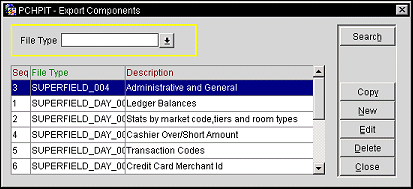
Delivery Configuration. When OXI or SFTP is selected, the Delivery Configuration button displays. Select this option to launch the Export File Delivery Configuration screen. Delivery Configuration allows you to configure a file location to which the Export should be copied and a delivery method to be used to send the Export File. See OXI - Export File Delivery Configuration Screen, SFTP Export File Delivery Configuration Screen, and HTTP/HTTPS Export File Delivery Configuration Screen below.
Export Definitions. This option is available when the export requires the property to define specific export codes and corresponding values before running the export. Select this button to display the Export Definitions screen.
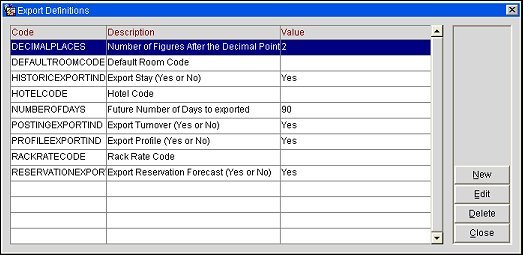
To add a new export code and its value, select the New button. To change details for an existing code, highlight your choice and select the Edit button. The Export Definitions - New or Export Definitions - Edit screen appears.
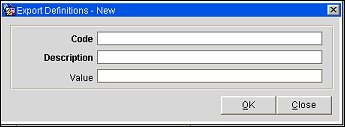
Enter the export Code, Description, and Value. Select the OK button to save and return to the Export Definitions screen.
Note: Depending on the export template, specific codes and possibly default values may auto-populate the Export Definitions screen.
When the OXI option is selected on the Export File Details screen the Delivery Configuration button allows you to configure the location and delivery method for sending the selected Export File to OXI displays. If no file location/delivery method is configured, the OXI Configuration settings for the selected Export in OXI Communication Method Setup will determine these options.
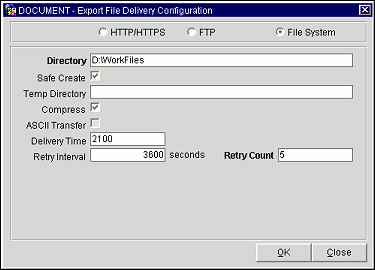
Provide the following information and select the OK button.
Select the File System radio button to configure delivery of the export file using the file system method.
Directory. Select a directory name to the local and/or network location to which the export will be delivered.
Temp Directory. Select a location as a temporary directory to copy the Export File to. A Temp Directory serves as a location to house files that are incomplete or that have failed delivery to the desired location.
Compress. Select the Compress check box to compress the File Export into a zipped file.
ASCII Transfer. Select this option to transfer the Export File in ASCII format.
Delivery Time. Enter the time at which the Export File is to be delivered to the desired location.
Retry Interval. Enter the time (in seconds) with which to reattempt a previously failed delivery.
Retry Count. Number of times re-delivery should be attempted.
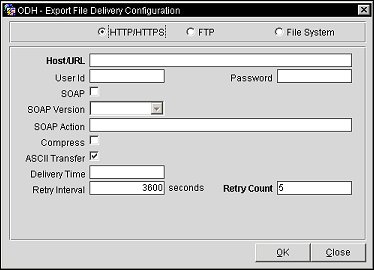
Provide the following information and select the OK button.
Select the HTTP/HTTPS radio button to configure delivery of the export file using the HTTP/HTTPS method.
Host/URL. Enter the path and directory name of the network location to which the export will be delivered.
User ID. Enter the user ID required to log onto the host site, if necessary.
Password. Enter the password for the user ID to log onto the host site, if necessary.
SOAP. Select this check box if a SOAP protocol is to be used for extracting the XML. SOAP (Simple Object Access Protocol) is a simple XML-based protocol to let applications exchange information over HTTP/HTTPS.
SOAP Version. If a SOAP protocol is being used, select the version of SOAP from the drop down list.
SOAP Action. If a SOAP protocol is being used, enter the SOAP action to be applied by the Web Service, if necessary.
Compress. Select to compress the file export into a zipped file.
ASCII Transfer. Select to transfer the export file in ASCII format. ASCII is simply the American Standard Code for Information Interchange and gives an alternate way to exchange data.
Delivery Time. Enter the time at which the export file is to be delivered to the desired location.
Retry Interval. Enter the amount of time, in seconds, after which to reattempt a previously failed delivery of the export. For example, if 3600 is entered in this field, once an exports delivery fails it will try to deliver the export again to the desired location after 3600 seconds or 1 hour.
Retry Count. Enter the number of delivery reattempts in the event of a failed delivery of the export. When the Retry Count is greater than 0, the export will be retried that number of times daily until it is successfully delivered.
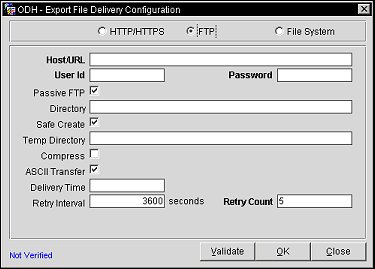
Provide the following information and select the OK button.
Select the FTP radio button to configure delivery of the export file using the FTP method.
Host URL. Enter the URL of the FTP site to which the export file will be sent.
User ID. Enter the user ID required to log onto the FTP site.
Password. Enter the password required to log onto the FTP site.
Passive FTP. Select to send the export file in Passive Mode FTP. In active mode FTP communication, client connects to the FTP server to send commands and then the server connects back to the client to send the data. If there is firewall in between that does not allow connection back to the client, this will not work. In passive mode FTP the client initiates both connections to the server, solving the problem of firewalls filtering the incoming data port connection to the client from the server.
Directory. Enter the name of the directory (including path) on the FTP site where the export file will be stored.
Safe Create. Select to upload the data into a temporary file on the FTP server and then rename it once the upload is completed to the actual file to prevent server side programs from reading incomplete files.
Temp Directory. When Safe Create is selected, enter the where to upload the file temporarily, once the upload is completed, the file will be moved from this directory to the data directory entered under Directory field.
Compress. Select to compress the FTP export file into a zipped file.
Note: The Content Type of a compressed file is 'application/x-zip-compressed'.
ASCII Transfer. Select to transfer the export file in ASCII format. ASCII is simply the American Standard Code for Information Interchange and gives an alternate way to exchange data.
Delivery Time. Enter the time at which the export file is to be delivered to the desired location.
Retry Interval. Enter the amount of time, in seconds, after which to reattempt a previously failed delivery of the export. For example, if 3600 is entered in this field, once an exports delivery fails it will try to deliver the export again to the desired location after 3600 seconds or 1 hour.
Retry Count. Enter the number of delivery reattempts in the event of a failed delivery of the export. When the Retry Count is greater than 0, the export will be retried that number of times daily until it is successfully delivered.
Validate. Select to test the validity of the location and delivery method information you have specified. OPERA will attempt to contact the FTP site using the information you have provided. If the validation is successful, "Valid" will display in blue type at the bottom-left of the screen. If the validation fails, a "Connection could not be established" message screen will open and "Invalid" will display in blue type at the bottom-left of the screen.
Note: If the location and delivery method information has not been verified via selection of the Validate button, "Not Verified" will display in blue type at the bottom-left of the screen.
In all OPERA tables, credit card numbers and expiration dates are stored as encrypted. Based on the Reservations>Credit Card Information View user permission being granted, users will either be able to view the credit card information or not on OPERA Screens.
Regardless of the Credit Card Information View permission, the user will not be able to modify export data containing credit card information. The credit card information on export files output will not be masked.
If the Credit Card Information View permission is not granted, credit card numbers and expiry dates in the export data generated will be fully masked with X's when displayed on screen where export data can be seen. If the user has the Credit Card Information View permission granted, then they will be able to view the number in the export data generated but still not be able to modify it.
When requested to do so by OPERA Support staff, Export Message Logging may be activated for use in debugging export issues. See Export Message Logging for details.
See Also